What is Multichain? Multichain is one of two popular development directions in the crypto market besides cross-chain. Vitalik once said that cross-chain is much riskier than multichain, that’s why multichain is the future of the crypto market. To understand more about multichain, let’s learn together in the article below.
What is Multichain?
Overview of multichain
TThe term multichain, also known as multi-chain in the crypto market, is often used to refer to projects operating on many different blockchains such as Ethereum, Arbitrum, Fantom,… To be called a multichain project, projects must operate at least 2 Blockchains or more. Some typical examples are:
- Uniswap is currently available on Blockchains such as Ethereum, Polygon, Arbitrum, Optimis,… which means that users can buy and sell tokens on Uniswap on Blockchains where this Uniswap is present.
- AAVE is present on many blockchains such as Ethereum, Polygon, Fantom, Metis, Harmony,…
- SushiSwap is currently available on 26 different Blockchains.
Note: Here I am not mentioning the Multichain project working on the cross-chain segment.
Advantages of multichain

What is Multichain?
Multichain development projects will have some of the following advantages:
- Projects developing on many new blockchains such as Fantom, Arbitrum, Avalanche,… help protocols take advantage of high speed and low cost.
- The project reaches many new users on the new Blockchain, thereby generating more revenue and expanding its influence.
- The project can receive cash flow on new projects, thereby also generating more revenue for the protocol.
- The security capabilities of multichain projects are somewhat higher and better than cross-chain protocols.
Disadvantages of multichain
Multichain development projects will have some of the following disadvantages:
- Appearing on many different blockchains causes the protocol’s liquidity to be fragmented. That makes the liquidity on a blockchain not high, leading to higher Impermanet Loss and Slippage.
- Although multichain is developed, the protocols do not allow cross-chain swaps or money transfers between one blockchain and another.
- Lack of prioritization from the foundation project. Usually platform blockchains will support native projects more.
- If moving to a new blockchain, developers have to learn more programming languages and spend more on product audits.
Difference between multichain & cross-chain
There is a lot of confusion between multichain and cross-chain. Let’s quickly differentiate.
- Multichain: Used to refer to projects operating from 2 or more blockchains.
- Cross-chain: Used to refer to projects that provide cross-chain services such as swapping from chain A and receiving money in chain B or depositing money in chain A and receiving money in chain B, we often call them bridge-oriented projects.
Obviously the two concepts multichain & cross-chain are completely different.
Some outstanding multichain projects
Some prominent multichain projects in the market include:
- Sushiswap is one of the pioneer AMMs in the multichain movement when present on 26 different blockchains.
- AAVE is also a multichain Lending & Borrowing platform. It can be said that during AAVE’s operation, it was a guideline for cash flow. When it appeared on this blockchain, TVL there skyrocketed.
- Curve Finance is also a successful multichain StableSwap platform as all the blockchains that Curve is present in are top TVL projects.
The future of multichain
Surely multichain will continue to stick with and accompany the DeFi market in particular and the crypto market in general in the future. But perhaps multichain projects need to integrate technology to be able to develop in parallel with the market, for example:
- Integrates Omni-chain technology of LayerZero or Wormhole.
- Supports even non-EVM Blockchains. Multichain projects are quite “lazy” in approaching non-EVM blockchains.
Summary
I believe that multichain will still be one of the strategic directions of both old and new projects to reach more markets.


